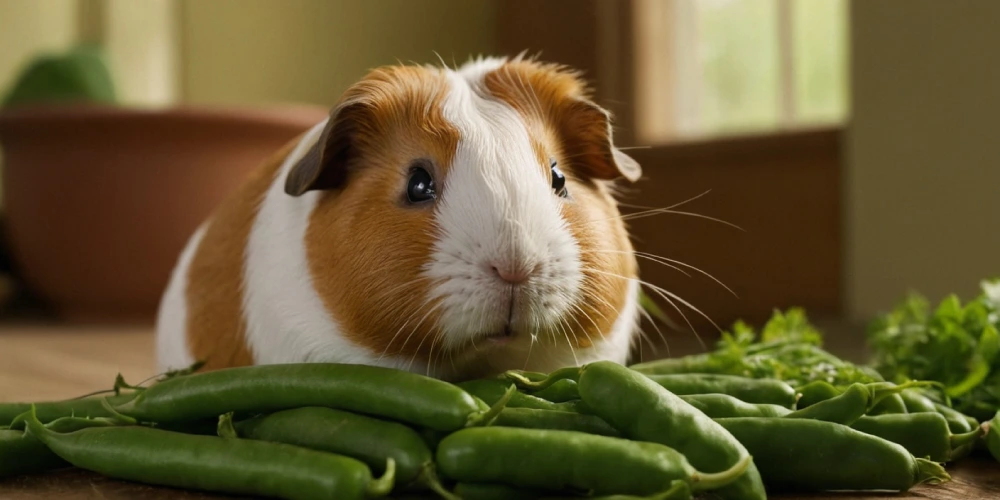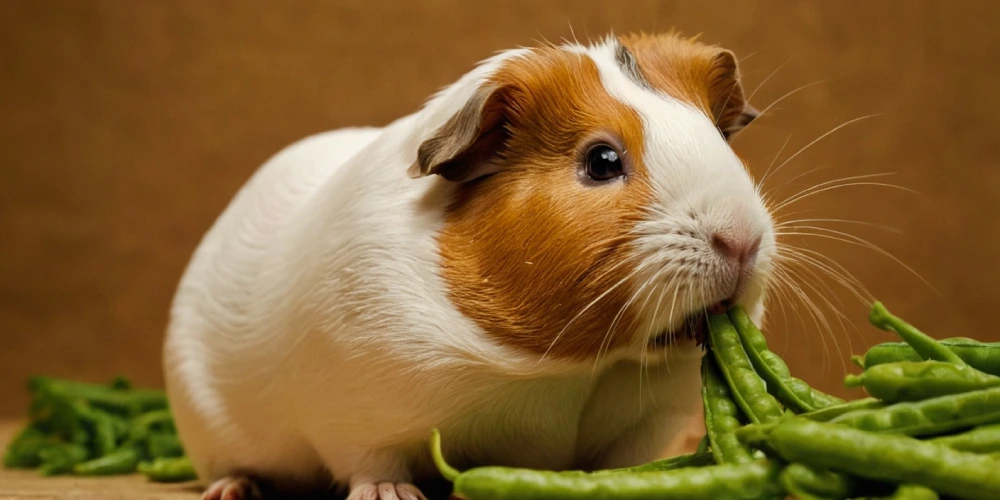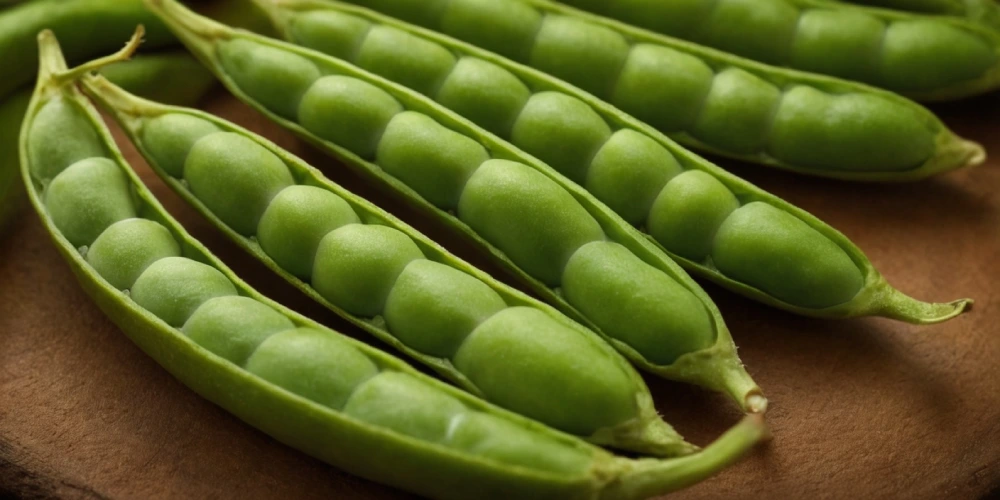
Can Guinea Pigs Eat Pea Pods?
Guinea pigs are small animals that love to eat fresh vegetables. They have specific dietary needs, and as pet owners, it is important to ensure they are fed safe and nutritious food. One common question is whether pea pods can be included in their diet. Pea pods are the outer shells of peas and are often crisp and sweet, making them a tempting option to share with guinea pigs. However, like any new food, it’s important to understand if they are safe and healthy.
Pea pods can be a healthy treat for guinea pigs when given in moderation. They are rich in vitamins and fiber, which help guinea pigs stay healthy. However, not all pea pods are the same, and some can have more sugar or other nutrients that might not be ideal for your pet. Understanding how to prepare and serve pea pods to guinea pigs safely is key to keeping them happy and healthy. The nutritional advantages of pea pods will be discussed in this post, along with how to include them in the diet of your guinea pig and what care should be taken.

What Are Pea Pods?
Pea pods are the green outer shells that hold the peas inside. There are different types of pea pods, such as sugar snap peas, snow peas, and garden peas. Some pea pods are tender and edible, while others might be tough to chew. For guinea pigs, only the tender, soft pea pods should be considered.
Sugar snap peas and snow peas are ideal for guinea pigs because their pods are softer and easier to digest. These types of pea pods are often sweet and full of nutrients. On the other hand, garden peas usually have pods that are too tough and fibrous, making them harder for guinea pigs to chew and digest.
Pea pods are not just empty shells. They have minute levels of vitamins, including vitamin C, which guinea pigs cannot generate on their own. However, it’s important to ensure the pea pods you offer are fresh, clean, and free from pesticides.
Nutritional Value of Pea Pods
Pea pods are packed with nutrients that can benefit guinea pigs. They contain vitamins, minerals, and fiber, all of which contribute to a guinea pig’s health. Below is a breakdown of the key nutrients found in pea pods and why they are beneficial:
1.Vitamin C
Guinea pigs need Vitamin C to stay healthy. This vitamin helps boost their immune system and prevents scurvy, a common illness in guinea pigs. Pea pods contain a moderate amount of Vitamin C, making them a good supplement to their diet.
2.Fiber
Guinea pigs need fiber to maintain their stomachs in good condition and help with digestion. Pea pods, with their reasonable fibre content, can help avoid digestive problems, including constipation or bloating.
3.Low Fat and Calories
Pea pods are low in fat and calories, making them a great snack for guinea pigs. They provide nutrients without contributing to weight gain, which is important for keeping guinea pigs at a healthy weight.
While pea pods are nutritious, they also contain natural sugars. In guinea pigs, too much sugar can lead to complications, including obesity or dental abnormalities. This is why it’s important to feed pea pods in moderation.
Benefits of Feeding Pea Pods to Guinea Pigs
Pea pods can be a wonderful addition to a guinea pig’s diet when given in small amounts. Here are some key benefits:
1.Encourages Hydration
Pea pods have a high water content, which helps keep guinea pigs hydrated. Their general health depends on enough water, particularly in hot months.
2.Provides Mental Stimulation
Guinea pigs enjoy chewing on fresh vegetables like pea pods. This activity helps keep them entertained and can even improve their dental health by preventing overgrown teeth.
3.Boosts Nutrition
Adding pea pods to a guinea pig’s diet introduces variety and extra nutrients. This helps ensure they get a well-rounded diet, especially when combined with other fresh vegetables.
Pea pods are a great treat, but despite their advantages, they should not be a regular meal. Overfeeding any single food item can lead to nutritional imbalances.

How to Safely Feed Pea Pods to Guinea Pigs
Feeding pea pods to guinea pigs is simple, but there are some important steps to follow to ensure they are safe and healthy:
1.Choose Fresh Pea Pods
Always select fresh, green pea pods. Avoid wilted, moldy, or discolored pods, as they can be harmful to guinea pigs.
2.Wash Thoroughly
Before feeding, wash the pea pods under running water to remove any dirt or pesticides. Even organic produce should be cleaned thoroughly.
3.Cut into Small Pieces
Guinea pigs have small mouths, so cutting the pea pods into bite-sized pieces can make it easier for them to chew and digest.
4.Serve in Moderation
Pea pods should be given as a treat, not as a main meal. Limit the serving to one or two small pieces a few times a week.
5.Monitor Your Guinea Pig
Once you start pea pods, keep an eye on your guinea pig for any indicators of digestive trouble or discomfort. If they show signs like diarrhea or bloating, stop feeding pea pods and consult a veterinarian.
Following these steps helps ensure that your guinea pig enjoys pea pods safely and without any negative side effects.

Potential Risks of Feeding Pea Pods to Guinea Pigs
While pea pods can be a healthy treat, they also come with some risks if not fed properly. Here are a few potential concerns to keep in mind:
1.High Sugar Content
Pea pods, especially those from sugar snap peas, contain natural sugars. Too much can cause oral problems and weight gain.
2.Digestive Upset
Guinea pigs have sensitive digestive systems. Introducing too many new foods, including pea pods, can cause diarrhea or bloating. Therefore, novel meals should always be introduced gradually and in tiny quantities.
3.Pesticides and Chemicals
If pea pods are not washed properly, they may contain harmful pesticides or chemicals. This is why cleaning them thoroughly is essential.
4.Tough Pods
Some pea pods, like those from garden peas, are too tough for guinea pigs to chew. These can create stomach problems or a choking risk.
By being aware of these risks and taking precautions, you can safely include pea pods in your guinea pig’s diet.
How Often Should Guinea Pigs Eat Pea Pods?
Pea pods should be an occasional treat rather than a daily food item. A good rule of thumb is to offer pea pods 1-2 times a week, along with a variety of other vegetables. This ensures your guinea pig gets a balanced diet without overloading on any single nutrient.
When serving pea pods, keep the portion size small. One or two pieces per guinea pig is enough. Overfeeding can cause digestive problems or obesity, among other health concerns. Recall that guinea pigs should eat mostly hay, fresh vegetables, and a small amount of pellets.
By keeping pea pods as a special treat, you can ensure your guinea pig enjoys their benefits without any negative side effects.
To Read More Guinea Pig Related Articles; Click Here
Conclusion
Pea pods can be a safe and healthy treat for guinea pigs when served correctly. They are rich in vitamins and fiber, which support a guinea pig’s overall health. However, it’s important to choose the right type of pea pods, serve them in moderation, and always wash them thoroughly.
Introduce pea pods gradually, as with any new meal, and be alert for any discomfort. By following these guidelines, you can add variety to your guinea pig’s diet and keep them happy and healthy.
FAQs
1.Can guinea pigs eat cooked pea pods?
No, guinea pigs should only eat raw pea pods. Cooking destroys some of the nutrients and changes the texture, making it harder for them to digest.
2.Are frozen pea pods safe for guinea pigs?
Frozen pea pods should be thawed completely and brought to room temperature before feeding. However, fresh pea pods are a better choice because they retain more nutrients.
3.Can baby guinea pigs eat pea pods?
Baby guinea pigs can eat pea pods, but only in very small amounts. Their digestive systems are still developing, so it’s best to introduce new foods slowly.
4.What other vegetables can guinea pigs eat?
Bell peppers, cucumbers, leafy greens, and carrots are among the vegetables guinea pigs can consume. Always introduce new foods one at a time to monitor their reaction.
5.How do I know if my guinea pig likes pea pods?
If your guinea pig enjoys pea pods, they will eagerly chew on them and finish their portion. If they leave the pea pods untouched, they may not like the taste or texture.
